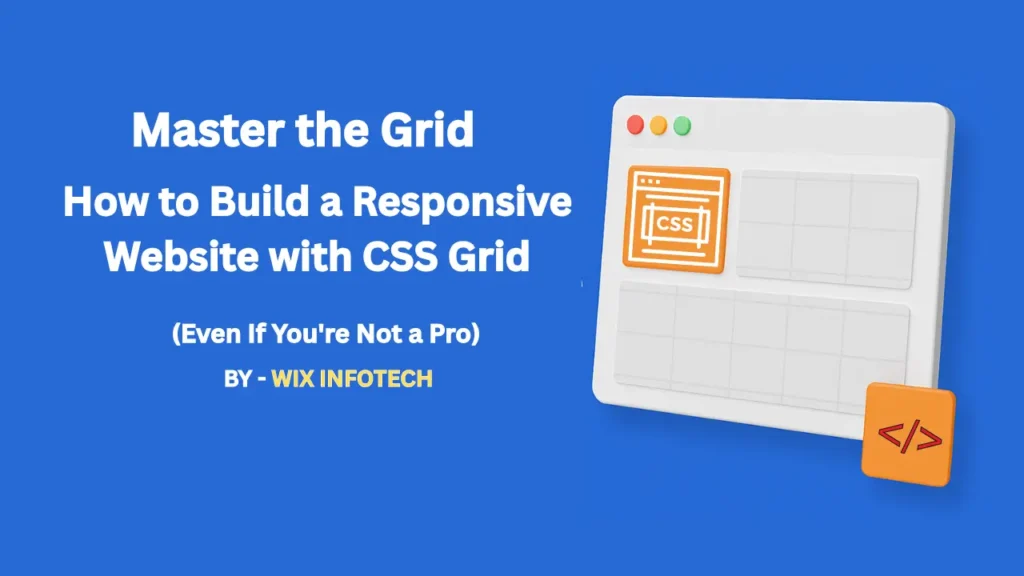Designing a responsive website doesn’t have to be overwhelming. With the power of CSS Grid, even beginners can craft flexible, professional layouts that look amazing on every screen—from smartphones to desktops.
In this article, you’ll learn how to build a responsive website with CSS Grid step-by-step. Whether you’re a small business owner, a freelance web designer, or just trying to level up your front-end skills, this tutorial will help you master one of the most powerful layout systems in modern CSS.
Let’s dive in.
What Is CSS Grid and Why Should You Use It?
CSS Grid is a layout system introduced in CSS3. It allows you to design web pages using a two-dimensional grid-based approach—making it ideal for complex layouts that need to adjust responsively.
Unlike Flexbox (which is one-dimensional), CSS Grid works both in rows and columns, giving you greater control over your layout structure.
Benefits of CSS Grid:
-
Perfect for responsive design
-
Cleaner and less code-heavy
-
Works seamlessly with modern browsers
-
Enables mobile-first design strategies
According to MDN Web Docs, Grid is now supported by over 96% of browsers globally—so it’s time to get comfortable using it.
How to Build a Responsive Website with CSS Grid (Step-by-Step)
Let’s build a simple layout: a header, a main content section with two columns, and a footer.
1. HTML Structure
<div class=”container”>
<header>Header</header>
<nav>Navigation</nav>
<main>Main Content</main>
<aside>Sidebar</aside>
<footer>Footer</footer>
</div>
2. CSS Grid Setup
.container {
display: grid;
grid-template-areas:
“header header”
“nav main”
“nav aside”
“footer footer”;
grid-template-columns: 1fr 3fr;
gap: 20px;
padding: 20px;
}
Now assign each element to a grid area:
header {
grid-area: header;
}
nav {
grid-area: nav;
}
main {
grid-area: main;
}
aside {
grid-area: aside;
}
footer {
grid-area: footer;
}
3. Make It Responsive
Use a media query to change the layout for smaller screens:
@media (max-width: 768px) {
.container {
grid-template-areas:
“header”
“nav”
“main”
“aside”
“footer”;
grid-template-columns: 1fr;
}
}
Now, on tablets or mobile devices, the layout will stack vertically—improving readability and usability.
Pro Tips for Building Responsive Layouts with CSS Grid
Use Fractional Units (fr)
Instead of using fixed pixel widths, CSS Grid allows you to use the fr unit, which stands for “fraction of available space.” This lets you create flexible layouts that automatically adjust to different screen sizes, making your design more responsive and scalable.
Combine with Flexbox
Flexbox still plays an important role alongside CSS Grid. It’s ideal for aligning content within grid areas—like centering text, spacing buttons, or positioning icons—making layouts more precise and visually balanced.
Avoid Over-Nesting
One of the key advantages of CSS Grid is its ability to eliminate excessive nested <div> elements. By organizing layouts more efficiently, it results in cleaner, more readable code—and that means faster load times and easier maintenance.
Related Articles 👉 Wix Search Console Verification: How to Get Your Site Indexed Faster by Google
Test Across Devices
Always preview your grid layout on different screen sizes. Use Chrome DevTools or tools like Responsively App.
Want this kind of site but don’t have time to code?
👉 Explore Our Web Development Services
👉 Get a Free Consultation
At Wix Infotech, we specialize in building responsive websites that not only look good—but also perform fast and rank high on search engines.
Real-World Use Cases of CSS Grid
Many modern sites—including eCommerce platforms and news sites—use Grid to manage dynamic layouts.
For example, Apple and Forbes use grid systems for their responsive product displays and article grids. (See Forbes for their homepage layout.)
You can also integrate Grid with platforms like WordPress, Wix, or Webflow using custom CSS panels.
Related Articles 👉 Unlock Higher Rankings: How to Add a Meta Tag to Your WordPress Home Page the Right Way
Final Thoughts
Learning how to build a responsive website with CSS Grid is a game-changer. It gives you full control over your design, reduces development time, and ensures your site adapts to every screen perfectly.
Whether you’re a solo entrepreneur or an agency developer, using Grid can streamline your workflow and improve your UX.
Need a hand getting started or want a site built for you?
📞 Let the experts at Wix Infotech help you build a responsive, SEO-optimized, high-performing website—without the stress.

